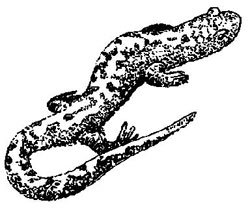The reason I was interested in that my wife is a current member of the trail crew after being a naturalist for six years.
She is? You mean she’s out there and helping to clear trails and things like that? Well, what a gal!
I should ask you about the congregation of newts in 1952?
I located two big aggregations of newts. The second of those two aggregations was found in the park after the programs had ceased for the year. I had access to a boat to look around the edges of the lake. One of the fellas working on the lake operated the boat for me. He and I hiked down there and picked up this boat, and we were rowing around the lake. It was then I found this enormous aggregation of newts gathered together. I collected them (7). You still have them there in the park collection, do you not?
Yes. You mentioned that there was no life history on the Mazama newt. Was that something you were thinking of doing at one point?
Well, of course, I was very much interested in salamanders, as you can see by the life history I have given you. It’s something that fascinated me during my graduate school days. As you look over the life history material, you will find out that my Ph.D. thesis was on the salamander chromosomes in an attempt to see if the chromosomes in the various species of salamanders will give us an insight into the evolutionary pattern of that particular group of amphibians.
I know that the Mazama newts is endemic. You talked at some length about the period when one species separates from another.
That is right. In the article there was discussed that particular thing, towards the end of it.
I know that the Mazama newts is endemic. You talked at some length about the period when one species separates from another.
That is right. In the article there was discussed that particular thing, towards the end of it.


